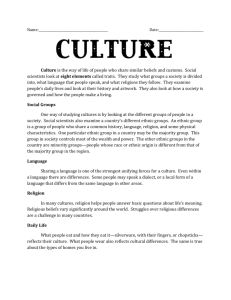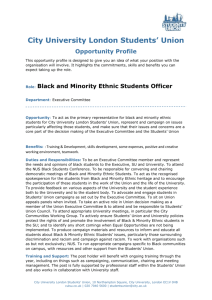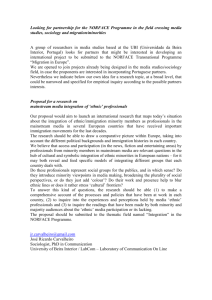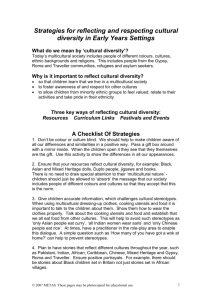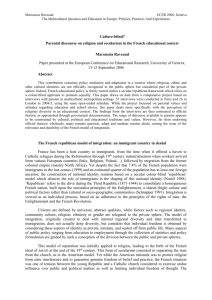Multicultural Diversity (2)
advertisement
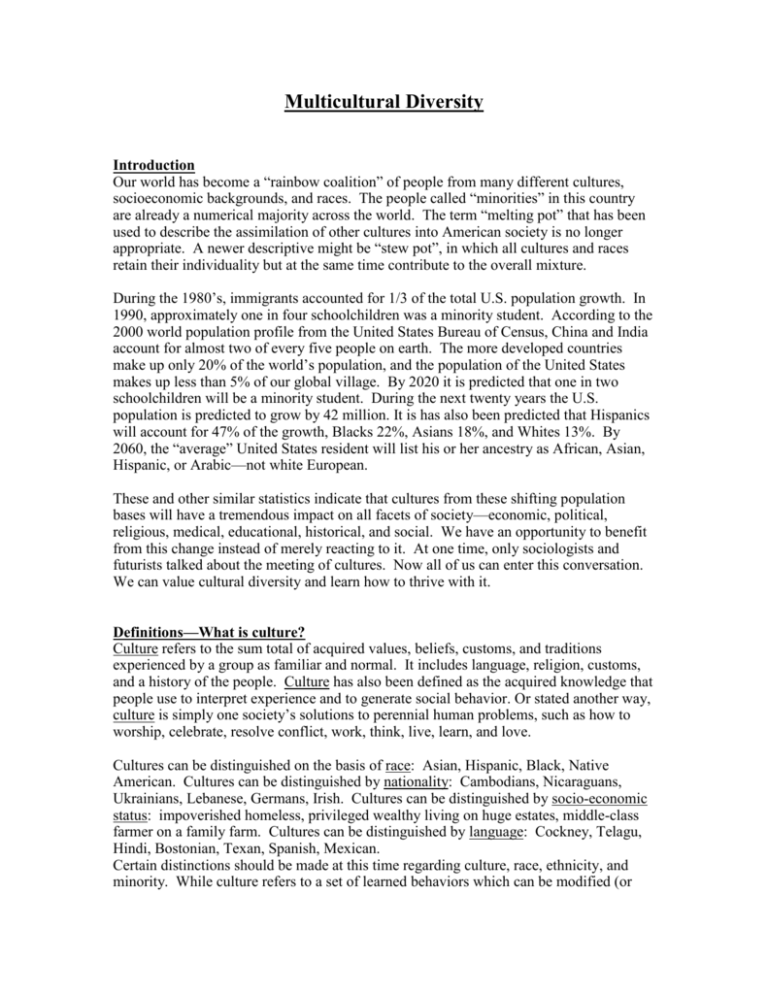
Multicultural Diversity Introduction Our world has become a “rainbow coalition” of people from many different cultures, socioeconomic backgrounds, and races. The people called “minorities” in this country are already a numerical majority across the world. The term “melting pot” that has been used to describe the assimilation of other cultures into American society is no longer appropriate. A newer descriptive might be “stew pot”, in which all cultures and races retain their individuality but at the same time contribute to the overall mixture. During the 1980’s, immigrants accounted for 1/3 of the total U.S. population growth. In 1990, approximately one in four schoolchildren was a minority student. According to the 2000 world population profile from the United States Bureau of Census, China and India account for almost two of every five people on earth. The more developed countries make up only 20% of the world’s population, and the population of the United States makes up less than 5% of our global village. By 2020 it is predicted that one in two schoolchildren will be a minority student. During the next twenty years the U.S. population is predicted to grow by 42 million. It is has also been predicted that Hispanics will account for 47% of the growth, Blacks 22%, Asians 18%, and Whites 13%. By 2060, the “average” United States resident will list his or her ancestry as African, Asian, Hispanic, or Arabic—not white European. These and other similar statistics indicate that cultures from these shifting population bases will have a tremendous impact on all facets of society—economic, political, religious, medical, educational, historical, and social. We have an opportunity to benefit from this change instead of merely reacting to it. At one time, only sociologists and futurists talked about the meeting of cultures. Now all of us can enter this conversation. We can value cultural diversity and learn how to thrive with it. Definitions—What is culture? Culture refers to the sum total of acquired values, beliefs, customs, and traditions experienced by a group as familiar and normal. It includes language, religion, customs, and a history of the people. Culture has also been defined as the acquired knowledge that people use to interpret experience and to generate social behavior. Or stated another way, culture is simply one society’s solutions to perennial human problems, such as how to worship, celebrate, resolve conflict, work, think, live, learn, and love. Cultures can be distinguished on the basis of race: Asian, Hispanic, Black, Native American. Cultures can be distinguished by nationality: Cambodians, Nicaraguans, Ukrainians, Lebanese, Germans, Irish. Cultures can be distinguished by socio-economic status: impoverished homeless, privileged wealthy living on huge estates, middle-class farmer on a family farm. Cultures can be distinguished by language: Cockney, Telagu, Hindi, Bostonian, Texan, Spanish, Mexican. Certain distinctions should be made at this time regarding culture, race, ethnicity, and minority. While culture refers to a set of learned behaviors which can be modified (or even rejected) over time, the concept of race is a social construction used to group humans on the basis of observable biological and physical traits such as size, skin color, hair texture, or facial features. Current scientific classifications recognize five racial categories: Mongoloid (Asian), Negroid (South American and African), Caucasoid (North American, European, Australian), Malayan (Hispanic), and Native American. An ethnic group is a community of people within a larger society that is socially distinguished or set apart, by others and/or by itself, primarily on the basis of racial and/or cultural characteristics, such as religion, language, and tradition. An ethnic group may be distinguished by “race, religion, or national origin”. The central factor is the notion of being set apart from the larger society; the distinctiveness may be based on either physical or cultural attributes, or both. An ethnic group may also be an ethnic minority, but not always. Examples of ethnic groups include: White Americans, African Americans, American Indians, Eskimos, Asians (Indians, Russians, Chinese, Japanese, etc.), Pacific Islanders (Hawaiians, Samoans, Guamanians, etc.), Hispanics (Mexicans, Puerto Ricans, Cubans, etc.), Jews, and Muslims. Religious denominations can also be considered ethnic groups, such as Protestants (Methodists, Baptists, Church of Christ, etc.), Fundamentalists (Assembly of God), Evangelical, Catholic, Orthodox (Greek, Russian, Jewish), Mormons, or even nondenominational churches. The term minority refers to a segment of society that is not necessarily less in number, but in some way considers itself to be inferior or have lesser status than the so-called majority. In fact, a numerical minority may control a numerical majority, as in the example of plantation owners who oversaw slave laborers. From a sociological perspective, whether or not an ethnic group is also a minority group depends on the degree to which it holds a subordinate status in the society. Most social scientists view ethnic groups as minorities when they: Suffer discrimination and subordination within a society; Are set apart in terms of physical or cultural traits disapproved of by the dominant group; Share a sense of collective identity and common burdens; Inherit their group membership at birth; and Marry primarily within their groups. The degree to which an ethnic group retains minority group status depends on how it is received by and/or receives the predominant society. It is important to realize, however, that individuals in the same ethnic group differ in their experiences associated with minority status, including prejudice, discrimination, and feelings of powerlessness. Importance of Communication Communication occurs because humans are social: we desire to interact with others. Communication occurs whenever we do something (e.g. talk, wave, smile) that is observed and responded to by another. What we choose to focus on and how we choose to interpret the message is a part of our cultural framework. All tutoring occurs in a physical and social context which influences communication. The following are some examples of both verbal and nonverbal communication that differ due to cultural background. 1. Spacing 2. Language Usage 3. Slang 4. Gestures 5. Touch 6. Eye Contact 7. Color 8. Dress 9. Environment 10. Responses to elders and authority Components of a Multicultural Framework 1. Avoid “Us” and “Them” Thinking. Every group by definition is an “us”, and everyone not in the group belongs to “them”. Remember different people experience the world in many different ways. Recognize that the experiences of those traditionally not in the majority culture are more likely to include discrimination and exclusiveness. By being sensitive to this as a tutor, you can better enter into and develop productive working relationships with tutees. 2. Understand Institutional Prejudice. Many students have not been served well by their schools and, as a result, they may approach you with some degree of skepticism. In a society in which we espouse values of inclusion of all, opportunity for all, and fair treatment to all, those who seem “different” are often systematically excluded, denied opportunities, and treated unfairly. The reverse may also be true. If you survived inequities you may be more cynical or skeptical about school than some of your tutees. Either way, it is important to understand we all have different attitudes toward school, depending in large part on our experiences. If you are fair, communicate clearly, and are open to people different than you, then your relationships with each tutee can be mutually positive and productive. 3. Generalize Cautiously. You may be a minority tutor who experienced little discrimination in schools. Conversely, you may work with a white student who did experience some kind of discrimination in schools. You can’t assume that every white person had every advantage in school and that every African American or Hispanic student had every disadvantage. Generalizations about a group don’t necessarily apply to a given individual in that group. As a tutor, focus on the individuals you work with, utilizing what you know about their backgrounds as possible influences. Be aware of stereotypes in your own thinking and avoid letting them creep in our tutoring. Tips for Working with Multicultural Students 1. 2. 3. 4. 5. 6. 7. 8. Ask questions: Look for common ground. Share background information. Speak clearly, naturally, and avoid using slang. Use repetition—you repeat directions, tutee repeats directions. Frequently ask the student if what you are saying makes sense. Use restatement to clarify the student’s response—“I think you said……” If the student does not understand you, write down what you are saying. If you do not understand the students, ask them to write down what they are saying. 9. Encourage students to read out loud and to use their dictionaries. 10. Use gestures, but sparingly. 11. Discuss expectations. 12. Other Conclusion The greater our knowledge of other cultures, the easier it is for us to be tolerant. The more we explore our differences, the more we can discover our similarities.
